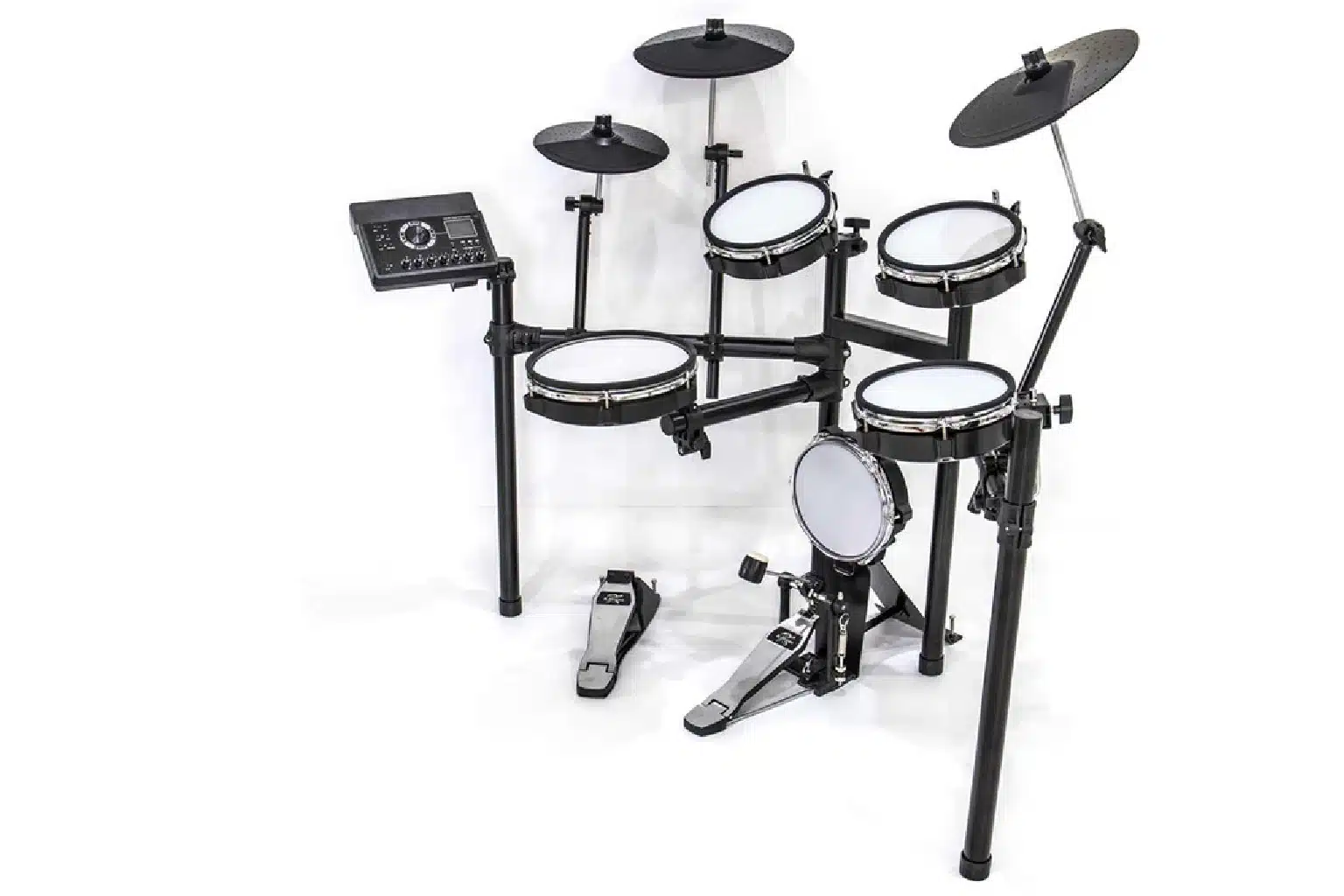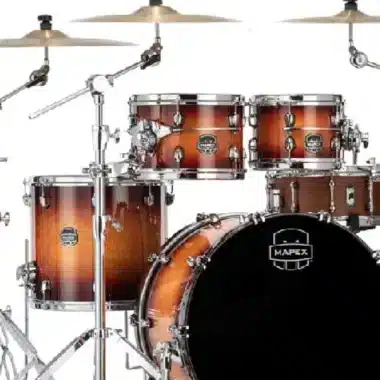Why Choose an Electric Drum Set?
Drumming has come a long way with advancements in technology, and electric drum sets are now a popular choice among musicians of all skill levels. Whether you’re a beginner exploring rhythms or an experienced drummer seeking versatility, an electric drum set offers unique benefits over traditional acoustic kits. They’re quieter, more compact, and packed with a wide range of sounds, making them perfect for home practice, studio recording, and live performances.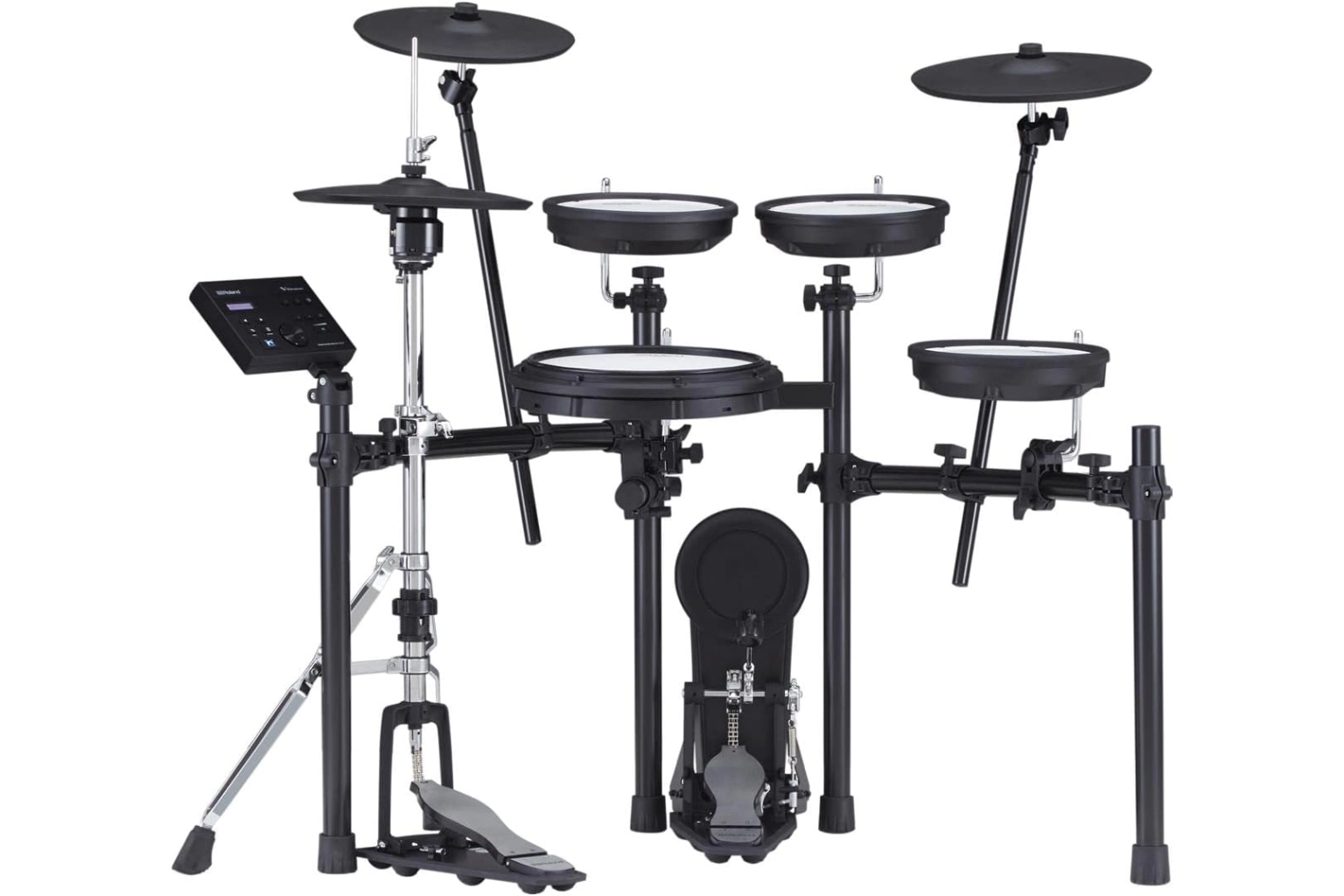
Chapter 1: What Is an Electric Drum Set?
An electric drum set, also known as an electronic drum kit, is a modern drumming solution that combines electronic technology with the traditional feel of a drum kit. Instead of using wooden shells, metal cymbals, and acoustic skins, electric drums feature drum pads and cymbal pads, usually made of rubber or mesh material, to produce sound through electronic sensors. When a drummer strikes these pads, the sensors detect the impact and send signals to a central sound module, often referred to as the “brain” of the kit. This module then generates a sound that mimics the tone and feel of traditional acoustic drums or produces a wide range of synthesized sounds.
A major advantage of electric drum sets is their ability to offer a broad array of sound options in one kit. Drummers can choose from preset sounds like rock, jazz, or hip-hop kits, and even explore unique, customized electronic sounds. This flexibility makes electric kits a favorite among musicians who play various styles or experiment with different genres. Additionally, because the volume can be controlled and headphones can be used, electric drum sets are ideal for quiet practice environments, making them suitable for homes or shared spaces.
Electric drum kits also come with features not found in acoustic drums, such as integrated metronomes, practice exercises, and play-along tracks that enhance learning and timing skills. Many models also offer recording capabilities, allowing drummers to connect to computers or digital audio workstations (DAWs) through MIDI or USB for easy recording and editing. This feature is highly beneficial for musicians who want to create high-quality recordings in a home studio setup.
While they lack the natural resonance of an acoustic drum kit, high-end electric drums can capture the nuance and dynamic range of real drums quite well. Pads that support multi-zones allow drummers to play different sounds based on where they strike, which helps mimic the feel of traditional cymbals and toms. Whether for practice, performance, or studio recording, electric drum sets have become a popular choice, providing a versatile, quiet, and convenient alternative to traditional drumming.
Chapter 2: Benefits Of Electric Drum Sets
Electric drum sets offer numerous benefits that make them a compelling choice for drummers of all levels, from beginners to seasoned musicians. Their unique features and flexibility make electric kits a versatile alternative to traditional acoustic drums, addressing many common challenges and providing a valuable practice and performance tool.
Volume Control for Quiet Practice
One of the most significant advantages of electric drum sets is their volume control. Drummers can play without disturbing others by using headphones, making these kits ideal for shared living spaces, apartments, or late-night practice sessions. This controlled volume allows players to practice as much as they want without worrying about noise complaints or bothering family members or neighbors. For drummers who value peace and flexibility, this feature alone can make an electric kit worth considering.
Sound Variety and Customization
Electric kits often come with sound modules that house hundreds of different drum sounds and percussion effects, allowing players to explore various styles and genres. Switching from rock to jazz, hip-hop to electronic, or even creating unique sounds is as simple as pressing a button. This wide range of sounds can add a creative edge to drumming, providing a cost-effective way to experiment with multiple styles without needing additional instruments. For musicians who play in different bands or frequently experiment with new sounds, this versatility is a major advantage.
Compact Design and Portability
Electric drum sets are generally more compact than their acoustic counterparts, making them suitable for small spaces. Many kits are designed to fold up or be rearranged, allowing easy storage and transportation. This compact design makes electric kits an excellent option for drummers with limited space at home or those who need a portable kit for gigs and travel. Acoustic kits, by comparison, can be bulky and challenging to move frequently, requiring more space and setup time.
Integration with Digital Tools
Electric drum sets are also compatible with modern digital tools and software. With USB or MIDI connections, these kits can connect to computers, digital audio workstations (DAWs), and virtual instruments, making recording and editing simple and efficient. This connectivity allows drummers to record high-quality audio from home without the need for specialized microphones or soundproofing, which can be costly. Furthermore, using MIDI connections gives players access to a range of virtual instrument libraries and sound customization options. For drummers interested in producing or recording, this capability adds a significant advantage.
Practice and Learning Tools
Many electric kits come with built-in tools like metronomes, coaching features, and practice exercises that help develop timing, technique, and consistency. Some modules even include play-along tracks, allowing drummers to jam along with preset songs, which can be a great way to practice timing in a musical context. These built-in features make electric kits especially beneficial for beginners, who may find structured practice tools helpful in their development, and experienced players who want to refine their skills.
Durability and Low Maintenance
Electric drum sets require less maintenance than acoustic kits, as there are no drumheads to tune or replace and no cymbals that risk cracking. While regular cleaning and occasional checks on electronic components are recommended, the upkeep is generally low, especially with kits from reputable brands known for quality and durability.
Electric drum sets offer flexibility, customization, and practicality that suit a wide variety of players. Whether used for practice, performance, or recording, these kits bring a range of benefits that can enhance a drummer’s experience and provide an accessible, versatile, and innovative approach to modern drumming.
Chapter 3: Key Features to Look For in an Electric Drum Set
When choosing an electric drum set, several key features can greatly impact your playing experience, versatility, and overall satisfaction. Understanding these features will help you make an informed decision that best aligns with your drumming style, skill level, and long-term goals. Here’s a guide to the most important aspects to consider.
1. Drum Pad Material and Feel
The material and design of the drum pads are critical because they affect the feel and response of the kit. Electric drum pads are typically made from rubber or mesh. Rubber pads are common on entry-level kits; they’re durable and affordable but can feel less like acoustic drums due to their firm rebound. Mesh heads, found on mid-to-high-end kits, provide a more realistic feel with better response and rebound similar to traditional drum skins. Mesh heads also allow for adjustable tension, giving you control over the feel of each pad. If you’re looking for a more authentic drumming experience, mesh pads are usually worth the investment.
2. Sound Module (The “Brain”)
The sound module is arguably the most critical component of an electric drum set, as it controls the quality and variety of sounds available. A good sound module offers a wide selection of drum kits, from classic acoustic sounds to electronic and experimental kits. High-quality modules allow for sound customization, letting you adjust individual elements to tailor each kit to your preferences. Advanced modules may also include effects such as reverb, pitch control, and equalization, which add depth to your sound and give you more flexibility. For drummers who want versatility and creativity, a high-end module with customization options can make a big difference.
3. Pad Sensitivity and Dynamic Response
Sensitivity and dynamic range are essential features that determine how accurately the kit responds to different levels of force. High-end electric drum kits often come with multi-zone pads that register different sounds depending on where the pad is struck. For instance, some cymbal pads can register both a bow and edge sound, while snare pads might allow for rim shots and cross-sticks. The better the sensitivity, the more nuanced your playing can be, as the kit will accurately capture soft hits, accents, and other dynamic details. If expressiveness is important to your style, look for a kit with multi-zone pads and dynamic sensitivity.
4. Connectivity Options
Many drummers use electric kits for recording or digital production, so connectivity is an essential feature. Look for a drum set with USB or MIDI compatibility, which allows it to connect easily to computers or digital audio workstations (DAWs). These features make it simple to record and integrate with virtual instruments or software effects, opening up new possibilities for creativity and production. Kits with audio outputs also enable easy connection to external speakers for live performance.
5. Expandability
As you progress, you might want to add additional pads or upgrade components, so consider whether the drum set allows for expandability. Some kits come with ports for adding extra cymbal or tom pads, which can increase your kit’s versatility and longevity. If you anticipate wanting to expand, choose a model with this flexibility to avoid the need for a complete upgrade down the line.
6. Built-in Practice Features
Many sound modules offer practice tools, like a built-in metronome, rhythm coaching exercises, and play-along tracks. These tools can be valuable for developing timing, improving technique, and staying motivated. Some kits even include coaching modes that analyze your timing and provide feedback, making practice more structured and effective. For drummers at any level, these features can significantly improve practice quality.
7. Durability and Quality of Build
Electric drum kits, like any musical equipment, are an investment, so durability is key. Check the quality of the materials used in the pads, rack, and module. Kits from reputable brands like Roland, Yamaha, and Alesis are often known for their durability, with stable racks, quality electronics, and components that withstand frequent use.
By focusing on these essential features, you can find an electric drum set that matches your needs, supports your progress, and provides a satisfying, enjoyable drumming experience for years to come.
Chapter 4: Top Electric Drum Set Brands and Models
When exploring electric drum sets, several top brands and models stand out for their quality, sound options, and features that cater to a range of drumming needs. Here’s a look at some of the most popular brands and models in the market.
1. Roland V-Drums Series
Roland is known for its high-quality V-Drums series, which has become the gold standard in the electric drum world. With realistic sounds, durable mesh heads, and highly responsive pads, Roland kits suit both beginners and professionals. Models like the Roland TD-1K are budget-friendly, offering essential features for newcomers, while the TD-27KV caters to advanced drummers, providing customizable sounds and a dynamic range close to an acoustic kit.
 2. Yamaha DTX Series
2. Yamaha DTX Series
Yamaha’s DTX series offers quality and versatility, making it a favorite for drummers of all levels. Yamaha DTX kits are known for their realistic sounds and pad responsiveness. The DTX402K is a great starter kit with quality sounds at an affordable price, while the DTX6K-X provides high-quality drum samples and recording options, ideal for more advanced players.
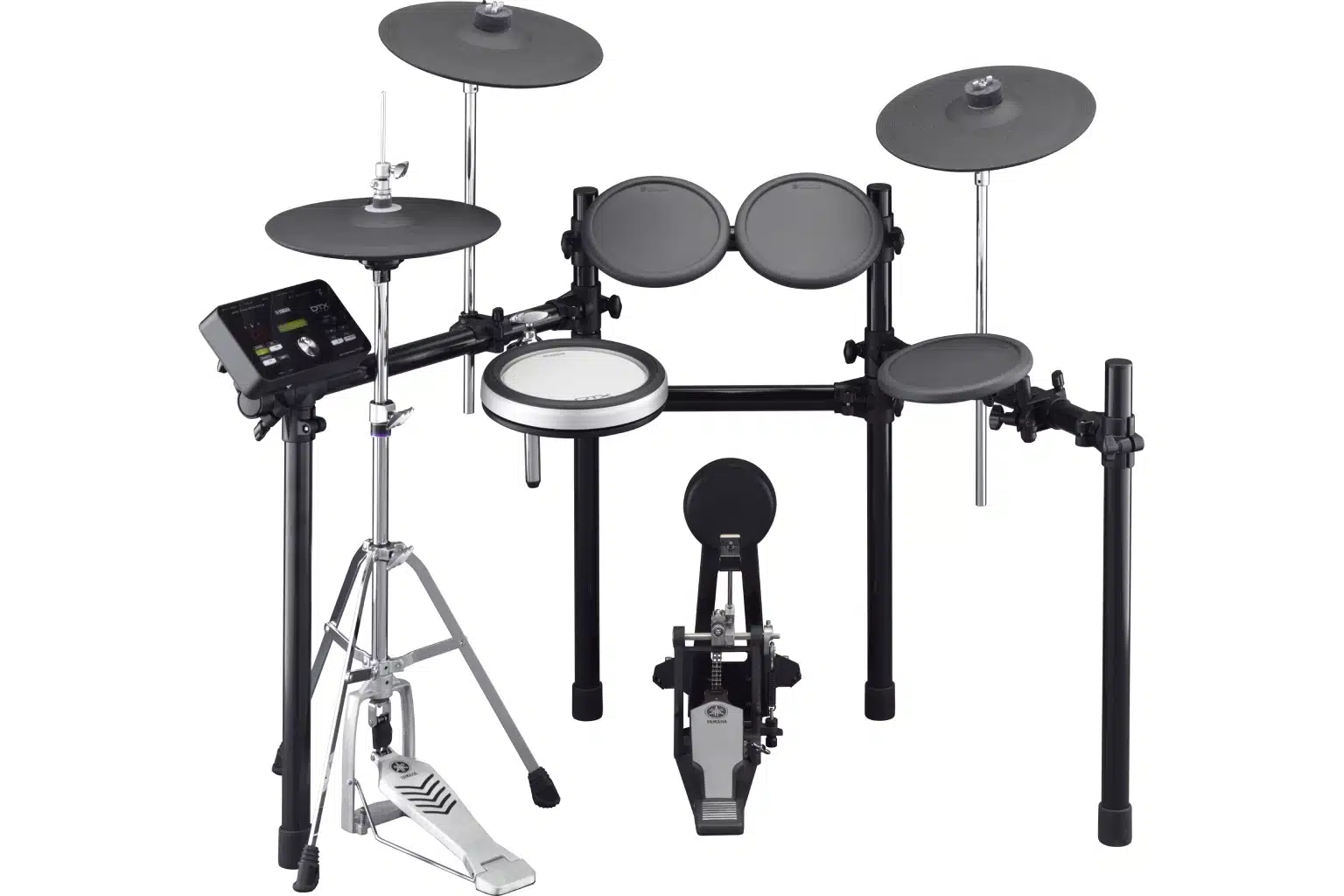 3. Alesis Electric Drum Kits
3. Alesis Electric Drum Kits
Alesis specializes in budget-friendly electric drum sets with features that rival higher-end kits. Their Nitro Mesh Kit and Surge Mesh Kit offer an affordable way to get started with electronic drumming, equipped with mesh pads and decent sound modules. The Alesis Strike Pro is a popular choice for drummers who want professional-grade features at a competitive price.
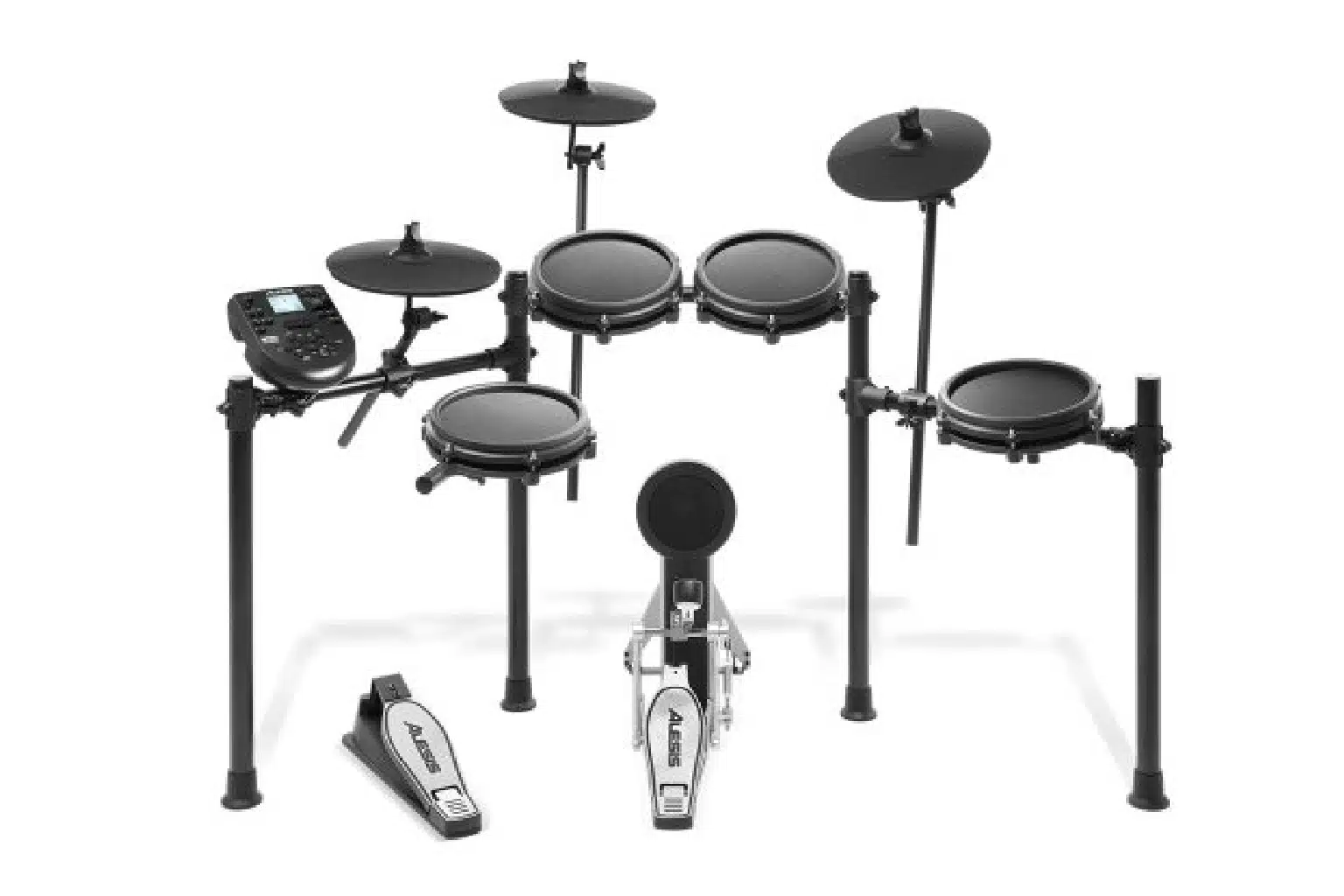 4. Simmons Drum Kits
4. Simmons Drum Kits
Simmons offers user-friendly electric drum kits with great durability, suited for beginner to mid-level players. The Simmons SD600 and SD1250 are well-regarded for providing quality sounds, simple setup, and reliable performance.
These brands offer diverse options to suit varying budgets, experience levels, and playing styles, making it easier to find the right electric drum set for your drumming journey.
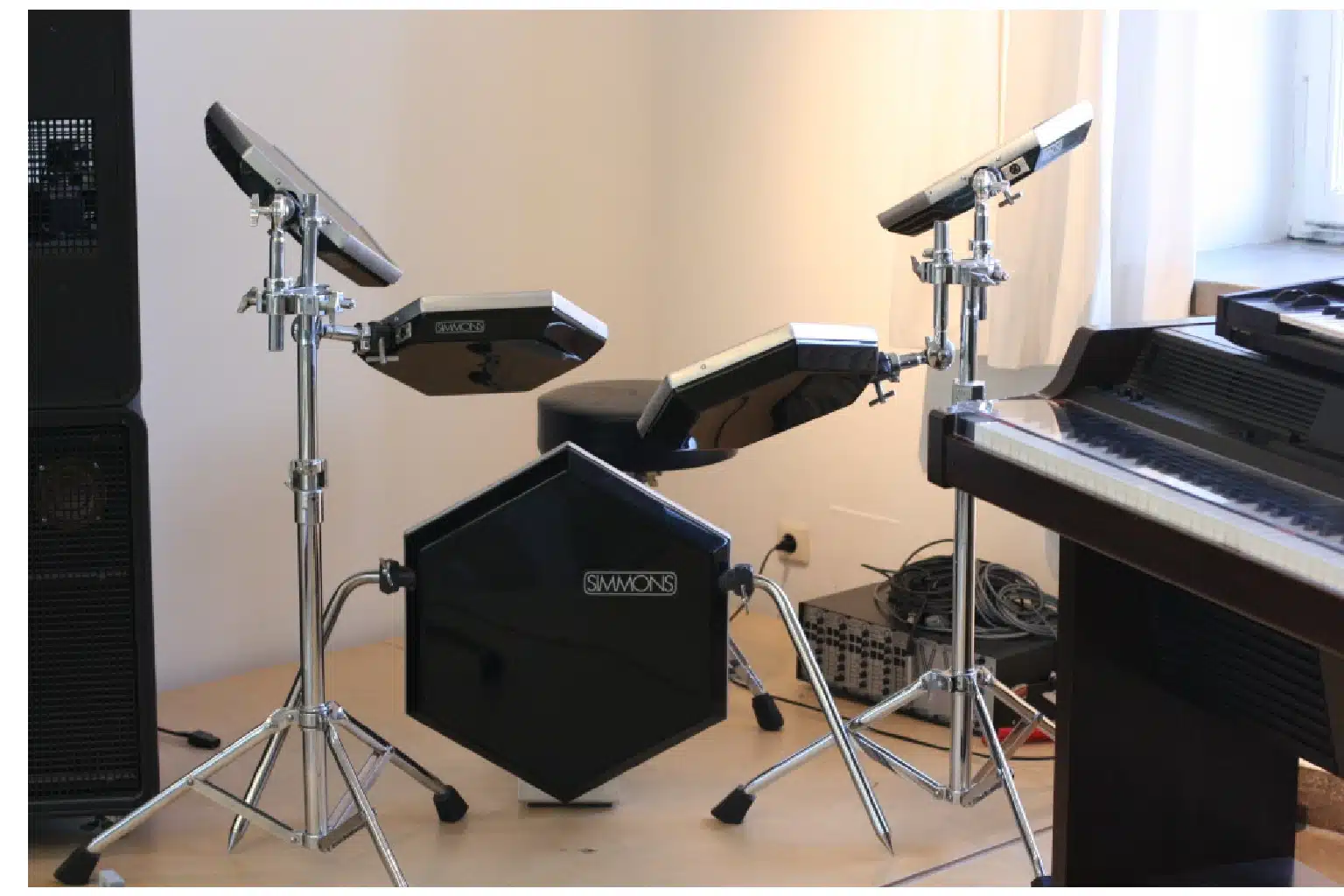
Chapter 5: Electric Drum Sets vs. Acoustic Drum Sets
When comparing electric drum sets to acoustic drum sets, both options have unique advantages and limitations. Choosing between the two often depends on factors such as volume control needs, space, sound versatility, and personal playing preferences. Here’s a breakdown of the differences to help you decide which best suits your drumming goals.
Volume Control and Practice Flexibility
One of the biggest advantages of electric drum sets is volume control. Since electric kits produce sound electronically, drummers can use headphones for a silent practice experience. This is ideal for those who live in apartments, shared spaces, or noise-sensitive environments, allowing for practice anytime without disturbing others. Acoustic drums, on the other hand, are naturally loud, which may limit practice hours unless the kit is used in a soundproofed area.
Portability and Space
Electric drum sets are generally more compact and lightweight compared to traditional acoustic drums, making them easier to transport and set up. Many electric kits are designed with foldable racks or modular components, allowing them to fit into smaller spaces and be stored conveniently. Acoustic drums, however, take up more room, with larger shells and multiple hardware pieces, making them challenging to move frequently or fit in limited spaces.
Sound Versatility
Electric drum sets come with preloaded sound modules that offer a wide range of drum kits and effects. Drummers can switch from a rock sound to jazz, electronic, or even custom sounds at the push of a button. This versatility makes electric kits ideal for musicians who play across various genres or experiment with new styles. Acoustic kits, while offering an authentic sound, are limited to the specific tone of the drum shells and cymbals, and changing the sound requires physical adjustments, such as swapping cymbals or tuning the heads.
Recording and Connectivity
Another major benefit of electric drum sets is their connectivity options. Many electric kits have USB and MIDI capabilities, making it easy to connect to digital audio workstations (DAWs) for recording or editing. This feature is useful for drummers who want to record high-quality audio without the need for external microphones or complex setups, and it’s particularly helpful in home studio settings. Acoustic drums, by contrast, require multiple microphones and careful soundproofing for optimal recording quality.
Playing Feel and Dynamics
Acoustic drums provide a natural response and resonance that many drummers find irreplaceable, particularly in live performances. High-end electric kits attempt to replicate this feel with advanced sensors and mesh heads, but some drummers still prefer the authentic sound and dynamics of acoustic drums. Ultimately, choosing between electric and acoustic drum sets depends on your specific needs, style, and preferences. Each has distinct advantages, making them suitable for different applications and musical environments.
Chapter 6: Setting Up and Maintaining Your Electric Drum Set
Setting up and maintaining an electric drum set properly can enhance both its performance and lifespan. Unlike acoustic kits, electric drum sets have electronic components and require different care techniques to ensure longevity and optimal playability. Here’s a quick guide to getting your electric drum set set up and keeping it in top shape.
Setting Up Your Electric Drum Set
- Choose a Stable Location
Start by choosing a stable, flat surface for your kit. Electric drums generally take up less space than acoustic kits, but it’s still essential to have enough room to play comfortably. Placing the kit on a drum mat can add stability and protect your floor from scratches. - Assemble the Rack
Electric drum sets typically come with a rack to which each drum and cymbal pad is mounted. Follow the manual’s assembly instructions closely to secure each piece in place. Begin by setting up the base rack, and then add each pad and module according to the specified locations, adjusting heights and angles for comfort. - Connect the Pads to the Sound Module
Each pad has a corresponding cable that connects it to the sound module, the “brain” of the kit. Properly connect these cables, ensuring they are securely plugged into the correct input. Many kits label each cable to make this step easier. - Adjust Pad Positions
Once assembled, adjust the height and angle of each drum and cymbal pad to suit your playing style and comfort. Taking time here to ensure an ergonomic setup helps with proper technique and prevents strain over time.
Maintaining Your Electric Drum Set
- Keep Pads Clean
Wipe down your drum and cymbal pads regularly with a soft, damp cloth to remove dust and residue from sticks. Avoid using harsh chemicals, as they can damage the pad surfaces. - Check and Secure Connections
Periodically check the connections between pads and the sound module to ensure they’re secure. Loose cables can cause dropped signals, interrupting play or practice sessions. - Update Firmware
Some high-end electric kits receive firmware updates that add features or improve performance. Checking for updates from the manufacturer can help keep your drum module up-to-date. - Store Carefully When Not in Use
If you need to disassemble or store your kit, carefully pack each component to prevent damage. Use protective covers for the module and pads if available, and avoid exposing the kit to extreme temperatures or moisture.
By setting up your electric drum set with care and following a few maintenance steps, you can ensure smooth operation and a responsive playing experience, while also extending the life of your kit.
Chapter 7: Tips for Getting the Most Out of Your Electric Drum Set
Electric drum sets offer a versatile and dynamic way to develop your drumming skills, but to truly make the most out of them, there are a few key tips and techniques to keep in mind. Here’s how you can maximize your experience and get the best performance out of your electric kit.
1. Utilize Sound Module Features
The sound module is the heart of your electric drum set, and most modules come loaded with an array of features designed to improve your playing and versatility. Start by exploring the different drum kits and sounds available—many modules include pre-set kits tailored to genres like rock, jazz, and electronic. Customizing your kits and creating unique sounds can be a fun way to tailor the kit to your style. If your module has effects like reverb or pitch control, experiment with them to add new dimensions to your practice.
2. Practice with Built-in Tools
Electric drum sets often have built-in practice tools, such as metronomes, rhythm training exercises, and tempo tracking features. A metronome, in particular, can be invaluable for working on timing and consistency. Some high-end kits even offer coaching functions that track accuracy and tempo control over time, helping you monitor your progress and refine your skills. Taking advantage of these tools can elevate your practice routine, making it both structured and measurable.
3. Integrate with Digital Audio Workstations (DAWs)
One of the major benefits of electric drum sets is their connectivity options, especially for recording. Most electric kits are MIDI-compatible, meaning they can connect to a DAW on your computer via USB or MIDI. This setup allows you to record drum tracks easily, making it simple to capture your performance and edit it directly. Recording your practice sessions can be an excellent way to identify areas for improvement, and using DAWs also opens the door to integrating virtual instruments, sampling, and layering with other sounds.
4. Experiment with Different Sticks and Settings
Experimenting with different drumstick types and adjusting the settings on your electric kit can impact your playing experience. Lighter sticks can produce a quieter, more controlled sound on the pads, while heavier sticks can add power and feel closer to playing an acoustic set. Likewise, customizing pad sensitivity settings lets you fine-tune the response to match your playing style. Higher-end modules often have dynamic range settings that allow you to simulate soft to loud hits more accurately, which can be especially useful in developing nuanced playing techniques.
5. Upgrade Components When Ready
As your skills progress, consider upgrading components like the sound module or adding additional cymbals and toms to expand your kit. Some electric drum sets offer expandability, allowing you to add extra pads or switches for more sound options. Upgrading to a higher-end module or better-quality pads, such as mesh heads, can significantly enhance your kit’s performance, feel, and sound. Modular upgrades can help extend the longevity of your kit and keep it aligned with your evolving needs.
6. Focus on Ergonomic Setup
Comfort is essential for any instrument, and proper setup is crucial to ensure you’re practicing with the right form. Adjust each pad and cymbal to an ergonomic height and angle, mimicking the layout of an acoustic drum set. Doing so not only promotes good technique but also reduces strain on your wrists and shoulders over long practice sessions. Ensuring comfort from the start will support your posture and encourage proper form, helping you play better and avoid injury.
7. Engage with Online Resources and Communities
Learning from other electric drummers can be highly beneficial, as each kit has unique settings, tips, and tricks. Online resources like video tutorials, forums, and social media groups can offer a wealth of information on getting the best sound, finding the right settings, and maintaining your kit. Following tutorials that use your specific model can also reveal features you might have missed and provide new ideas to incorporate into your practice.
By exploring these tips and techniques, you can enhance your electric drumming experience, unlocking your kit’s full potential and improving your skills.
Chapter 8: Troubleshooting Common Issues
When using an electric drum set, a few common issues can arise, from connectivity problems to sound inconsistencies. Here’s a quick guide to troubleshooting these issues so you can get back to drumming without delay.
1. Pad Sensitivity Issues
If a pad feels unresponsive or overly sensitive, it may need sensitivity adjustment. Most sound modules allow you to tweak sensitivity settings for each pad individually, which can help if you’re experiencing missed hits or unwanted triggering. Refer to your drum module’s manual for instructions on adjusting pad sensitivity to match your playing style.
2. Crosstalk Between Pads
Crosstalk happens when striking one pad unintentionally triggers another nearby pad. This issue is often due to vibration transfer through the drum rack. To reduce crosstalk, try adjusting the “crosstalk” settings on your module (usually labeled “X-talk”) or slightly reposition the affected pads to minimize vibration interference. In some cases, adding rubber spacers between pads and the rack can help.
3. Connectivity Problems
If you’re experiencing trouble connecting your electric drum set to a computer or digital audio workstation (DAW), check your cables and USB or MIDI connections to ensure they’re secure. If the device isn’t recognized by your DAW, try updating your module’s firmware or checking for software compatibility. Using a different USB cable can also help diagnose a potential hardware issue.
4. Sound Module Malfunctions
Sometimes the module can freeze or act unpredictably. Resetting the module by turning it off and on can fix many minor issues. If problems persist, consider checking the manufacturer’s website for any software updates, as firmware updates can resolve glitches or add performance improvements.
By addressing these common issues and staying mindful of regular maintenance, you can enjoy a smoother experience with your electric drum set.

